Podcast: Play in new window | Download (Duration: 17:43 — 13.8MB)
Our next Halloween monster is the ahool, a mystery bat from Indonesia and Java, but along the way we’ll learn about megabats in general–especially the hammerhead bat! Thanks to Grace, Grace’s sons, and Tania for the hammerhead bat suggestion!
I’ve unlocked a Patreon bonus episode about burrowing bats, which you can listen to here.
A hammerhead bat (male) from side and front. DAT SNOOT. (Photos by Sarah Olson and swiped off the web, because I have no shame.)
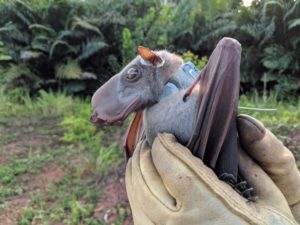
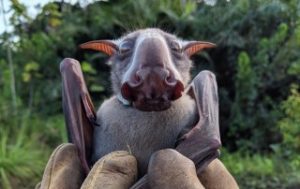
The Egyptian fruit bat (Photo by Amram Zabari and swiped etc etc):
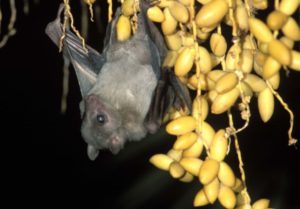
Great flying foxes, sleepin (photo by Lars Petersson and swiped etc etc):
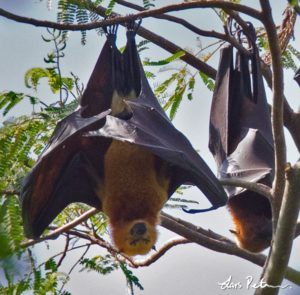
Golden-crowned flying fox, flyin (photo by Dave Irving and swiped etc etc):
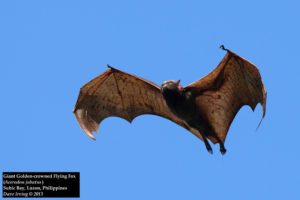
Show transcript:
Welcome to Strange Animals Podcast. I’m your host, Kate Shaw.
This week we’re going to learn about bats—some real, some mysterious, and all of them awesome, because bats are awesome! Listeners Grace and Grace’s sons requested an episode about hammerhead bats recently, which made me realize two things. One, I had never actually done a bats episode even though bats are one of my favorite animals, and two, back when listener Tania suggested hammerhead worms and other hammerhead animals, I totally forgot hammerhead bats were a thing!
As a special Halloween treat, I’ve unlocked a Patreon episode about burrowing bats that anyone can now listen to. I’ll put a link in the show notes, which you can click to listen on your browser. You don’t need a Patreon login or anything.
Bats are grouped into two basic types, microbats and megabats. Microbats are typical bats, usually small, flat-faced with big ears, that use echolocation to catch insects at night. Megabats are typically larger, with limited echolocation abilities and longer muzzles, and they often eat fruit. They’re sometimes called fruit bats collectively. We’re going to focus on megabats in this episode.
Let’s start with the hammerhead bat. It lives in parts of Africa near the equator, in forests and swamps, and mostly eats fruit. It especially likes figs. So do I, big flappy bat friend. It’s a big bat, with a wingspan over three feet wide, or 97 cm. Males are larger than females, and males tend to fly farther to find fruit while females generally stick to areas they know.
During the day the hammerhead bat roosts high up in trees. Researchers think it’s nocturnal mostly because it tends to overheat while flying. Naturally it prefers to nap when it’s hottest out and is only active at night when it’s cooler.
The hammerhead bat’s body is furry, with leathery wings and a mostly bare nose, although it also has long whiskers. Its fur is mostly brown or gray-brown, but its shoulders are white and it has a tuft of white fur at the base of its ears. Its tail is short and its eyes are large.
Most of what a hammerhead bat does is typical for other fruit bats. But it differs from other fruit bats in a big way. The hammerhead bat gets its name from the male’s face, which looks sort of mooselike with a big snoot, big lips, cheek pouches, a split lower lip, and a larynx that’s really big for the size of the throat. All these features allow the male hammerhead bat to make really loud honking noises to attract females. Females have smaller faces that resemble a fox or dog rather than a moose.
Often, males gather at night to honk and flap their massive wings, showing off for the females. Females fly around, checking the males out and probably giggling with each other about which ones they like best and who’s got the best voice.
This is what the hammerhead bat sounds like, although it’s not a great audio clip. At least it gives you an idea of what these bats sound like:
[hammerhead bats honking]
There are reports of the hammerhead bat attacking chickens and other birds to eat them. Fruit isn’t all that high in protein, so it could be that a bat occasionally needs nutrients it can’t get from its usual diet. This is not that uncommon in herbivorous animals, as it happens. Cows will occasionally eat chickens, deer and sheep will eat baby birds when they find them, and so forth.
Fruit bats of all kinds also visit mineral licks, especially pregnant females. But researchers have found that fruit bats don’t actually need those trace minerals. Fruit is rich in minerals. Researchers think the mineral-rich clay actually acts as a detoxifier for the bats, helping reduce the toxic effects of secondary plant compounds—leaves and unripe sections of the fruit, and so forth—that the bats eat every night that could otherwise make them sick.
Not a whole lot is known about the hammerhead bat or other megabats, for that matter. A recent discovery about how fruit bats navigate in the darkness suggests they actually use a rudimentary form of echolocation, but it’s very different from the echolocation used by microbats. For one thing, the clicking sounds they make aren’t vocalizations, they’re produced by the wings as the bat flies. For another, while the echolocation does help bats navigate, it’s not very accurate. Bats still sometimes crash into things. Researchers think echolocation has evolved separately in bats and that the megabat echolocation is not related to microbat echolocation.
The Egyptian fruit bat uses a more sophisticated version of echolocation, clicking its tongue to produce the signals it uses. It’s a relatively small megabat, with a wingspan of about two feet, or 60 cm, and it eats fruit, especially wild dates. Its echolocation is more like dolphin and whale sonar than microbat echolocation. It also has good eyesight and can easily switch between visual navigation and echolocating depending on how much light it has available.
Fruit bats are amazing flyers. Their wings are modified arms, with the fingers enormously elongated. The fingers are connected with tough but flexible skin called a membrane. Researchers have found that the membrane contains tiny muscles barely thicker than a hair that help the bat fine-tune the stiffness and shape of the membranes. This allows it to fly efficiently and quickly.
Many farmers think megabats destroy fruit crops, so they try to kill or drive off the bats. But while fruit bats do sometimes visit fruit farms, they are most likely to eat overripe fruit that was missed by pickers. This helps keep fungus and insect pests to a minimum, so it’s actually beneficial to fruit farmers. Unfortunately, many people just don’t like bats and blame them for damage to crops that’s actually done by other animals and by birds.
For instance, in Australia the flying fox is blamed for fruit crop destruction and the spreading of the Hendra virus and other diseases. But the flying fox mostly eats blossoms, especially of gum trees, along with insects, leaves, nectar, and some fruit. Birds are much more damaging to orchards. And while all bats can carry diseases, just as all mammals can, it’s not proven that the Hendra virus is spread by flying foxes at all. Domestic cats, on the other hand, do spread the virus. Keep your cats indoors. But the flying fox has been systematically persecuted in Australia for the last century, with several species having gone extinct as a result. This is a shame for many reasons, but especially because fruit bats of all kinds are important to the environment as seed dispersers and pollinators.
The biggest bat alive today is probably the great flying fox, which lives in New Guinea, Indonesia, and other nearby areas. Its wingspan can be nearly six feet across, or 1.8 meters. The golden-crowned flying fox, which lives in the Philippines, is very nearly as large, with a wingspan of over five and a half feet across, or 1.7 meters.
But there are reports of bats much larger than these. And that brings us to the ahool, a monstrous batlike creature reported from Java, Indonesia, and other areas.
The first official report of an animal called the ahool comes from western Java in 1927. Naturalist Dr. Ernst Bartels was in bed but still awake when he heard a loud call that sounded something like “a-hool!” Bartels rushed outside with a flashlight in hopes of seeing what animal had made the call, but he heard it again farther away, then again almost out of earshot.
As it happens, Bartels had grown up in western Java and knew about the legend of the ahool. It was supposed to be a monstrous bat, its wingspan some 12 feet across, or 3.6 meters. Its face was monkey-like with large eyes, and it was supposed to have feet that pointed backwards. During the day it was supposed to live in caves hidden behind waterfalls, but at night it flew out and scooped fish from the river.
Bartels did more research into the ahool legend, and eventually Ivan Sanderson, a cryptozoologist who had his hand in everything back in the day, contacted him with his own account. In 1932 Sanderson said he had seen a gigantic black bat in western Africa one night. He and his companion, naturalist Gerald Russell, had been searching for tortoises in a river when the bat flew over them. They both estimated its wingspan as 12 feet, and Sanderson said he could even see the sharp teeth in its open mouth.
Now, I can’t help but be skeptical of Sanderson’s sighting just because Sanderson was always having remarkable cryptozoological sightings with no proof but his own say-so. No one’s that lucky and unlucky at the same time. Dude should have carried a camera with him at all times, you know? Also, Bartels’ story was documented by Sanderson and is therefore a little bit suspect too.
But the ahool is an interesting cryptid because its description sounds so plausible. Even the backwards feet make sense, as bat feet have evolved to allow bats to hang upside down easily, which means when they’re right side up, their feet do appear to be backwards.
There are some discrepancies, though. Megabats all have long muzzles compared to microbats. The ahool is specifically described as having a flat face like a human or a monkey. While megabats aren’t all 100% frugivorous—that is, they don’t all eat nothing but fruit—none of them are known to eat fish. Some microbats do specialize in catching fish, though, and those bats all have longer snouts than typical insectivorous bats, although not as long as megabat snouts. And the ahool is said to stand or sit upright on the ground occasionally. While microbats sometimes do stand upright, megabats never do.
Sanderson proposed that the ahool may actually be an enormous microbat. Some microbats are actually pretty big, including the carnivorous ghost bat, also called the false vampire bat, which lives in parts of northern Australia. Its wingspan is almost 20 inches, or 50 cm. This is much larger than the smallest megabat, the spotted-winged fruit bat, which has a wingspan of only 11 inches, or 28 cm.
But microbats don’t make a lot of noise. It’s megabats who honk and call to each other rather than just squeaking. The ahool is supposedly named for its loud cry, the one Bartels heard. And remember that Bartels never saw the animal he heard.
So we have a few possibilities here.
Possibility one: the ahool is a real animal, exactly or mostly as described, with aspects of both megabats and microbats. It’s either incredibly rare or extinct these days, which would explain why there aren’t more sightings. If this is the case, it’s undoubtedly an animal completely new to science.
Possibility two: the ahool is a real animal, but it’s not well known because it’s so seldom seen. It seems to be a mixture of microbat and megabat because people who saw it made assumptions of its appearance based on what they know about bats. But some of those details are from microbats and some from megabats, and the actual animal may not look anything like its description in folklore. In this case, it’s probably a megabat.
Possibility three: the ahool is an animal entirely of folklore and myth, described as similar to various bats familiar to locals but enormously large. In this case, the myth may have grown up around the call, if the ahool’s call is that of a rare or migratory bird, seldom heard and therefore mysterious.
I can’t even make a guess as to which possibility might be the most likely, and that’s pretty awesome.
Let’s go back to the hammerhead bat for another mystery. A few years ago people started pointing out that the hammerhead bat looked a lot like drawings of the Jersey Devil, a cryptid supposedly seen in the southern New Jersey pine barrens. Newspaper accounts of the Jersey devil started circulating in the early years of the 20th century, although it may have been an established folktale before then. It’s usually described as having the head of a goat, bat wings, cloven hooves, and a forked tail, although its description varies from story to story. It’s more of an urban legend than a real cryptozoological mystery, to be honest. In 1909 a couple of guys bought a circus kangaroo, glued fake bat wings on it, and claimed they’d captured the Jersey devil.
So could someone have brought a male hammerhead bat to New Jersey and released it, where it subsequently inspired reports of the Jersey devil? I’m going to say no. The hammerhead bat can’t survive in cold weather, and if temperatures drop below 55 degrees F, or about 13 degrees C, it can’t even fly. Even if someone had captured one and somehow managed to keep it alive during the journey from equatorial Africa, how and why did it end up in the pine barrens of New Jersey? A bat that big would have excited comment even if only glimpsed in a cage on the docks, and would probably have been a big draw in traveling menageries. But there are no records of any giant bats in the area, and the theory that the Jersey devil was inspired by a hammerhead bat is a modern one. It’s still pretty cool, though.
Because bats are nocturnal and look scary, a lot of superstitions have grown up around them. Some cultures consider bats lucky, some unlucky. Some say you have to kill a bat to cancel out its bad luck, some say harming a bat will bring bad luck. But bats would avoid people completely if they could, and you don’t have anything to fear from them, not even bad luck.
I mean, except for the kind that can turn into actual vampires. Those are scary. Fortunately they only exist in horror movies.
You can find Strange Animals Podcast online at strangeanimalspodcast.com. We’re on Twitter at strangebeasties and have a facebook page at facebook.com/strangeanimalspodcast. If you have questions, comments, or suggestions for future episodes, email us at strangeanimalspodcast@gmail.com. If you like the podcast and want to help us out, leave us a rating and review on Apple Podcasts or whatever platform you listen on. We also have a Patreon if you’d like to support us that way.
Thanks for listening!